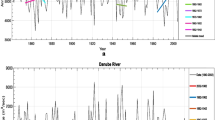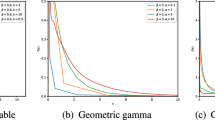Abstract
The present paper aims to model statistical structure of heavy-tailed precipitation data. In particular for agricultural purposes in Canadian Prairies, this is essential in many aspects such as assessing and managing risks resulting from the occurrence of unexpected precipitation events. Daily (or weekly) precipitation time series often contain many zeros (on dry days) and also exhibit important characteristics such as heavy-tailedness and volatility clustering. These features make it challenging to develop an effective model from both theoretical and practical viewpoints. In this paper, we propose a dynamic mixture model constructed based on a generalized Gaussian crack distribution with a GARCH specification to take into account the full range of precipitation measurements with a sufficient flexibility to fit both thin- and heavy-tailed data, and stochastic volatility. The method of maximum likelihood estimation with the profile log-likelihood algorithm is illustrated with some simulation studies. The model fitting results on a historical dataset from twelve stations in Canadian Prairies show the applicability of the proposed model.











Similar content being viewed by others
Availability of data and material
The datasets used in this study are available at the Government of Canada’s official website (http://www.climate.weather.gc.ca).
Code availability
The R codes may be provided upon request.
Notes
In the literature, GARCH(1,1) process is often used to model precipitation time series (Modarres and Ouarda , 2013).
References
Bae T, Chen J (2017) On heavy-tailed crack distribution for loss severity modeling. Int J Probab Stat 6(6):92–110
Benestad RE (2004) Record-values, nonstationarity tests and extreme value distributions. Glob Planet Change 44(1–4):11–26
Birnbaum ZW, Saunders SC (1969) Estimation for a family of life distributions with applications to fatigue. J Appl Probab 6(2):328–347
Birnbaum ZW, Saunders SC (1969) A new family of life distributions. J Appl Probab 6(2):319–327
Changnon SA, Changnon D, Fosse ER, Hoganson D, Roth R, Totsch J (1997) Effects of recent weather extremes on the insurance industry: major implications for the atmospheric sciences. Bull Am Meteor Soc 78(3):425–436
Davison AC (2003) Statistical models, vol 11. Cambridge University Press
Dunn PK (2004) Occurrence and quantity of precipitation can be modelled simultaneously. International Journal of Climatology: A Journal of the Royal Meteorological Society 24(10):1231–1239
Harvey A, Ito R (2020) Modeling time series when some observations are zero. J Econ 214(1):33–45
Hosking J (1990) L-moments: analysis and estimation of distributions using linear combinations of order statistics. J Roy Stat Soc B 52(1):105–124
Karl TR, Knight RW (1998) Secular trends of precipitation amount, frequency, and intensity in the United States. Bull Am Meteor Soc 79(2):231–242
Katz RW, Parlange MB (1995) Generalizations of chain-dependent processes: application to hourly precipitation. Water Resour Res 31(5):1331–1341
Lennartsson J, Baxevani A, Chen D (2008) Modelling precipitation in sweden using multiple step Markov chains and a composite model. J Hydrol 363(1–4):42–59
Modarres R, Ouarda TBMJ (2013) Modeling rainfall-runoff relationship using multivariate GARCH model. J Hydrol 499:1–18
Montero JM, Fernández-Avilés G, Mateu J (2015) Spatial and spatio-temporal geostatistical modeling and kriging. John Wiley & Sons
Nelsen RB (1999) An introduction to copulas. Springer
Nerantzaki SD, Papalexiou SM (2019) Tails of extremes: advancing a graphical method and harnessing big data to assess precipitation extremes. Adv Water Resour 134
Papalexiou SM, Koutsoyiannis D (2016) A global survey on the seasonal variation of the marginal distribution of daily precipitation. Adv Water Resour 94:131–145
Stern RD, Coe R (1984) A model fitting analysis of daily rainfall data. Journal of the Royal Statistical Society: Series A (General) 147(1):1–18
Torgo L (2010) Data mining with R: learning with case studies. CRC Press
Troyanskaya O, Cantor M, Sherlock G, Brown P, Hastie T, Tibshirani R, Botstein D, Altman R (2001) Missing value estimation methods for dna microarrays. Bioinformatics 17(6):520–525
Huser R, Davison AC (2014) Space–time modelling of extreme events. J R Stat Soc Ser B Stat Methodol 439–461
Papalexiou SM (2022) Rainfall generation revisited: introducing CoSMoS-2s and advancing copula-based intermittent time series modeling. Water Resour Res 58(6):e2021WR031641
Wilks DS (2011) Statistical methods in the atmospheric sciences, vol 100. Academic Press
Acknowledgements
The authors are grateful to the anonymous reviewers for valuable comments and suggestions.
Funding
This research is supported by the Discovery Development Grant from the Natural Sciences and Engineering Research Council of Canada (grant number DDG-2019-06064).
Author information
Authors and Affiliations
Contributions
All authors contributed to the study conception and design. Data collection and analysis were performed by Maral Mazjini. All authors read and approved the final manuscript.
Corresponding author
Ethics declarations
Conflict of interest
The authors declare no competing interests.
Rights and permissions
Springer Nature or its licensor (e.g. a society or other partner) holds exclusive rights to this article under a publishing agreement with the author(s) or other rightsholder(s); author self-archiving of the accepted manuscript version of this article is solely governed by the terms of such publishing agreement and applicable law.
About this article
Cite this article
Mazjini, M., Bae, T. Statistical modelling of precipitation data in Canadian Prairies with a dynamic mixture structure. Theor Appl Climatol 153, 173–192 (2023). https://doi.org/10.1007/s00704-023-04419-y
Received:
Accepted:
Published:
Issue Date:
DOI: https://doi.org/10.1007/s00704-023-04419-y




